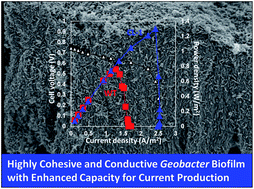The conductive biofilms of Geobacter sulfurreducens have potential applications in renewable energy, bioremediation, and bioelectronics. In an attempt to alter biofilm properties, genes encoding proteins with a PilZ domain were deleted from the G. sulfurreducens genome. A strain, in which the gene GSU1240 was deleted, designated strain CL-1, formed biofilms much more effectively than did the wild-type strain. Increased production of pili and exopolysaccharide were associated with the enhanced biofilm production. When grown with an electrode as the electron acceptor CL-1 produced biofilms that were 6-fold more conductive than wild-type biofilms. The greater conductivity lowered the potential losses in microbial fuel cells, decreasing the charge transfer resistance at the biofilm–anode surface by ca. 60% and lowering the formal potential by 50 mV. These lower potential losses increased the potential energy of electrons reaching the biofilm–anode interface and enabled strain CL-1 to produce 70% higher power densities than the wild-type strain. Current-producing biofilms were highly cohesive and could be peeled off graphite electrodes intact, yielding a novel conductive biological material. This study demonstrates that simple genetic manipulation can yield improved bioelectronics materials with energy applications.

You have access to this article
 Please wait while we load your content...
Something went wrong. Try again?
Please wait while we load your content...
Something went wrong. Try again?


 Please wait while we load your content...
Please wait while we load your content...